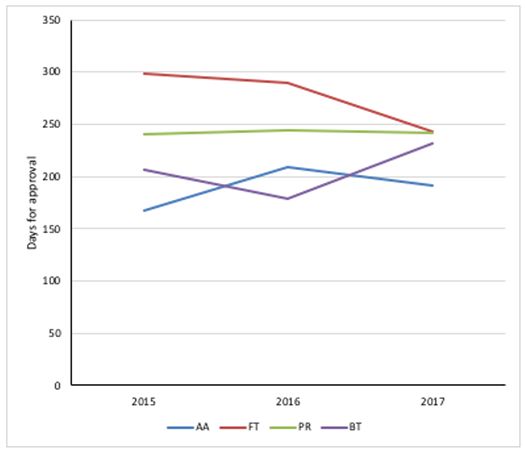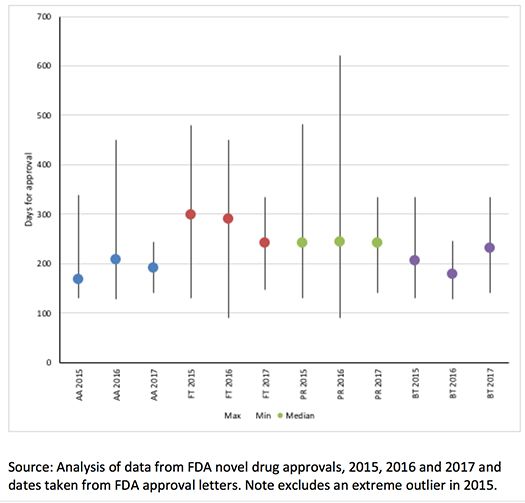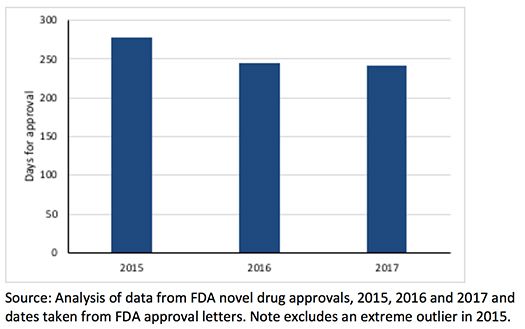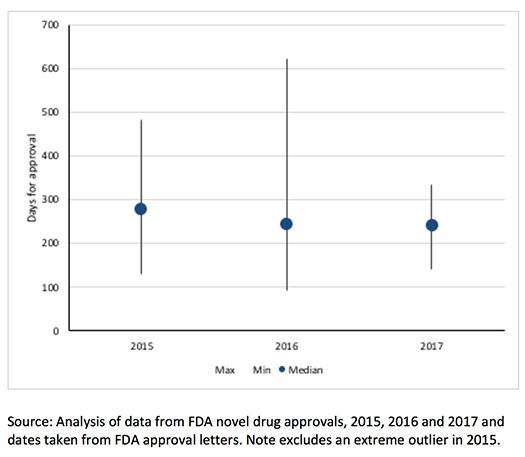How Fast are the FDA Fast Lanes?
There’s been a lot of talk about speeding up drug approval at FDA. So just how fast can approval be? Leela Barham takes a look at the speed of approval for each of FDA's expedited development and review methods.
There’s been a lot of talk about speeding up drug approval at FDA, especially from President Trump. So just how fast can approval be? In another in a series to explore the expedited FDA approvals, Leela Barham takes a look at the speed of approval for each of FDA's expedited development and review methods.
The options for faster FDA approval
There are four options to speed up FDA approval, set out in Table 1.
Table 1: Expedited development and review options at the FDA
Option
Aim
Benefits
Process
Fast Track (FT)
To facilitate the development and expedite the review of drugs to treat serious conditions and fill an unmet medical need
Requested by company with a decision from the FDA within 60 days of the request
Breakthrough Therapy (BT)
To expedite the development and review of drugs that are intended to treat a serious condition and preliminary clinical evidence indicates that the drug may demonstrate substantial improvement over available therapy on a clinically significant endpoint(s)
Requested by company or suggested by the FDA to the company that the company considers applying
Decision from the FDA within 60 days of the request
Accelerated Approval (AA)
Allows drugs for serious conditions that filled an unmet medical need to be approved based on a surrogate endpoint
Company and FDA discuss option
Priority Review (PR)
Directs overall attention and resources to the evaluation of applications for drugs where there would be significant improvements in the safety or effectiveness of treatment, diagnosis or prevention of serious conditions when compared to standard applications
FDA decides on review designation
Source: Summarized from FDA Fast Track, FDA Breakthrough Therapy, FDA Accelerated Approval and FDA Priority Review
It’s only under Priority Review that there is a clear time target set, but the others can help speed things up too.
Speeding up
President Trump has called the FDA approval process slow and burdensome and not only that, but he’s suggested that the agency process has kept too many advances from getting to those in need. Trump took up the Presidency in 2016, and full year data is available up to 2017, so it makes sense to take stock of the speed of FDA approvals using their expedited development and review methods from the year before Trump took office in 2015, through to 2017 as the latest year for which full data is available, to see just how slow the has been, and to see how fast it is now.
Looking over 2015 to 2017 shows that the median speed of approval when Accelerated Approval and Fast Track are used has fallen over time (Figure 1). That contrasts to the median speed of approval for Breakthrough Therapy designations that has slowed down, and Priority Review has stayed pretty much the same.
Figure 1: Trend in median approval times for novel drug approvals by FDA expedited development and review methods, 2015 to 2017
Source: Analysis of data from FDA novel drug approvals, 2015, 2016 and 2017 and dates taken from FDA approval letters. Note excludes an extreme outlier in 2015.

There is however variation: Priority Review can be both the fastest and the slowest of the expedited development and review options (Figure 2).
Figure 2: Trend in maximum and minimum approval times for novel drug approvals by FDA expedited development and review methods, 2015 to 2017

Of course, companies don’t just use one FDA expedited development and review method but use a combination of them. Taking the median approval times for all novel drugs approved using one or more of the expedited options shows an overall increase in speed (Figure 3). That becomes even more marked when it’s clear that the maximum and minimum approval times show less variation in 2017 than in both the previous two years (Figure 4).
Figure 3: Trend in median approval times for novel drug approvals using one or more FDA expedited development and review methods, 2015 to 2017

Figure 4: Trend in maximum and minimum approval times for novel drug approvals using one or more FDA expedited development and review methods, 2015 to 2017

Can approvals get any faster?
Based on the FDAs data from 2015 to 2017 shows that using FDA expedited options has been bringing approval timelines down over time. That must surely prompt the question whether approvals can get any faster? Afterall, fast approval needs to be balanced against safety and there could be such a thing as too fast.
Leela Barham is a freelance health economist and policy expert. You can reach her on leels@btinternet.com. She is providing input as a subject matter expert into medicines pricing policy development with a UK government client and for the duration of her involvement in that project, she is restricted on what she can write about.
Navigating Distrust: Pharma in the Age of Social Media
February 18th 2025Ian Baer, Founder and CEO of Sooth, discusses how the growing distrust in social media will impact industry marketing strategies and the relationships between pharmaceutical companies and the patients they aim to serve. He also explains dark social, how to combat misinformation, closing the trust gap, and more.
FDA Grants Priority Review to Regeneron’s Eylea for Macular Edema Following Retinal Vein Occlusion
April 18th 2025Regulatory action was based on data from the Phase III QUASAR trial, which demonstrated that Eylea HD dosed every eight weeks achieved non-inferior visual acuity outcomes compared to Eylea in patients with macular edema following retinal vein occlusion.